The Concise Illustrated History of 1920s Fashion and Style for Women. The trends, silhouettes, dresses, shoes, hats, hairstyles and makeup looks.

1920s Fashion History – Concise Guide to Dress and Style
Introduction
1.1920’s Fashion Trends
2.Art Deco and 1920’s Fashion
3.Evolution of the 1920’s Silhouette
4.Modernism in Fashion
5.1920’s Dress
a.1920’s Day Dress
b.1920’s Formal Dresses
c.The Flapper Dress
d.Home Dress Making
6.The 1920’s Flapper
7.1920’s Hairstyles and the Cloche Hat
8.1920’s Make-up
9. 1920’s Accessories
a. Bathing Suits
b.Lingerie & Stockings
c.Shoes in the 1920’s
10.End of the Flapper Era
2.Introduction

“With silken legs and scarlet lips
We’re young and hungry, wild and free,
Our waists are round about the hips
Skirts are well above the knee
We’ve boyish busts and Eton crops,
We quiver to the saxophone
Come, dance before the music stops
for who can bear to be alone?”
James Laver – The Women of 1926
The Times they are a Changing
The 1920s fashion era is unparalleled by the sheer magnitude of cultural change. It began in many ways with the spread of women’s suffrage in the immediate post war years. Some surprising late adopters of women’s suffrage were the United States in 1920 and France in 1945. The First World War blew apart the stifling control of class society in Europe, and women found a new sense of freedom and the right to feminine self expression.

Shop on Etsy for 1920’s Flapper | Gatsby Dresses

1920s Fashion Designers
As for changes in fashion, the huge influence of Paris designers like Poiret,Patou,Molyneux, Chanel, Lanvin, Lelong, Callot Soeurs and Vionnet cannot be underestimated. There were British designers such as Norman Hartnell – who went from catering exclusively to the wealthy upper class in the 1920’s to designing British women’s utility dresses in the early 1940’s.

The Impact of Culture on 1920’s Fashion
The arrival of the Jazz Age from the city of New Orleans and the music of Louis Armstrong became the anthem for the flapper, black or white and especially in the USA where alcohol was prohibited throughout the 1920’s and the term the ‘Roaring Twenties’ can be said to have been aptly applied.
The invention of film and the rising influence of Hollywood along with an increase in 1920s fashion marketing. The merging of the Arts Decoratifs and new Modernist movements. There was the cultural impact of a world war which reduced the grip of the class system on both sides of the Atlantic. Different classes and races mingled and shared their sense of freedom in the fight for suffrage. The rise of consumerism promoted the ideals of fulfillment and freedom.

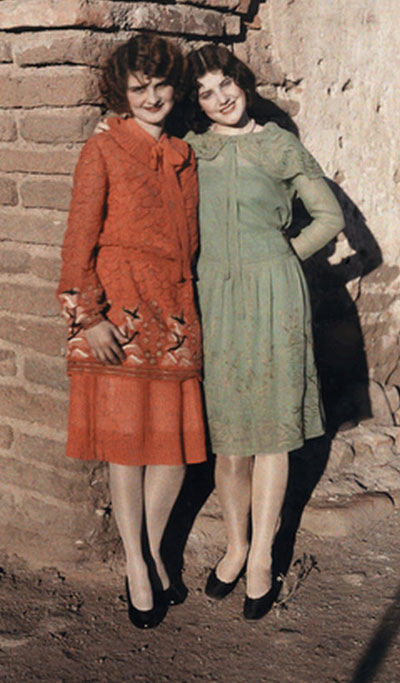
All these factors in post war culture would lead young women away from the Jane Austin era of corseted restrictions and ‘turns about the drawing room’.

As in the Belle Epoch of the 1900’s, there was a bohemian movement which flew the flag for freedom of self expression.
The 1920’s Cultural Explosion
The major cities of Paris, Berlin, New York and Washington were the social melting pots for the 1920’s cultural explosion. London of the 1920’s led the way in some respects with numerous infamous jazz clubs such as The Kit Cat Club, where the bright young things would carouse in decadence as satirized in Evelyn Waughs Vile Bodies.
The Wiemar culture of 1920’s Berlin immortalized by Christopher Usherwood in a series of Berlin novels inspired the 1960’s musical Cabaret . Fascism slammed the door shut all too quickly in Germany.
In the USA, the prohibition of alcohol produced the inevitable response of thousands of speakeasies springing up across the nation.
One Notable such club to hit the headlines was the Krazy Kat Klub in Washington.


The African American Impact on 1920’s Fashion
Perhaps the greatest gift to the 1920s fashion era came from the African-American – whose culture developed rapidly during the 1920’s under the banner of “The Harlem Renaissance”.
New Orleans Jazz made its way north to the segregated clubs of Chicago and New York, where the likes of Louis Armstrong and Duke Ellington, spread the musical message of freedom. In England, by the mid 1920’s, American Jazz was hurriedly replacing those boring old foxtrots.
The Impact of Automobiles on 1920’s Style

Auto-mobiles, promising adventure and freedom, were a factor in bringing about social change for women. The car continued to liberate women’s lifestyles as it had done in the 1910’s. The Rolls Royces, Cabriolets, Packards, and Horches were the domain of only the wealthy socialites. Chirpy ‘two dog cars’ like the Renault and Citroen or Bugatti enabled women of more modest means to enjoy the high life too!
1.1920’s Fashion Trends

- Robe de Style ( early 20’s) and Garcon Silhouette (mid to late 20’s)
- Chemise Dress hung from shoulder to knees
- Dropped Waist to Hip Levels
- Costume Jewelry, pearl necklaces, pearl drop earrings
- Cloche Hats
- Short Crop and Bob Hairstyles
- Pajama Suits
- Pleated Skirts, Sweater and Cardigan Combos
- Silk Stockings worn with T-Bar and Cross strapped Cuban heeled court shoes
- Velvet and Furs employed in Outerwear
- The Rise in Sportswear and Swimwear
- Increased use of Makeup

There was much more to 1920’s fashion trends than the iconic Flapper look of bobbed hair, long necklaces, cloche hats, flapper slang and the Charleston dance !
The explosion of creativity in stunning innovative styles in dress, hair, swimwear, shoes – the list goes on, all raised the bar to new heights. All subsequent eras would seek to emulate, re-create, or re-imagine the clothing styles pioneered by the 1920’s designers and the adventurous women who wore them!
Brief History of 1920’s Fashion Trends Video
The demure look of the 1920’s in Western fashion, was heavily influenced by the Art Decoratifs and emerging Modernist art movement.
The Chemise Dress

First appearing as an outerwear item in 1916 from designers such as Jeanne Lanvin , Callot Seours and Coco Chanel. By 1920, the chemise or shift dress, was to become the dominant line for day and evening wear. The dress hung from shoulder to just below the knee. Waists dropped to the hips. Back in the 1910’s, loose belts had often been worn over middy blouses and chemise dresses. It is quite possible the drop waist evolved from that style.

By launching her little black dress in 1926, Coco Chanel endorsed the validity of black as a fashionable color. She demonstrated a simple homespun wisdom in recognizing the colors capacity to flatter any figure.
Rising Skirt Hems

As the waist dropped to the hips, hems rose dangerously to the knee. This sudden exposure of women’s legs in the 1920s, brought about a huge interest in women’s hosiery. Stocking sales went through the roof. Silk was still the main sought after fabric. The popular colors were beige, grey and white.

With legs and shoulders becoming exposed, it appeared Madame Fashion was prepared to divest women of almost every last wisp of clothing.

In the colder months, a typical 1920s day dress outfit consisted of a blouse and pleated skirt, with either a cardigan, jacket or wrap-over coat for outdoors. Not forgetting the obligatory cloche hat to cover her bobbed hairstyle. On warm summer days, a favorite choice was a simple shift dress – often sleeveless, with a decolletage often as low as an evening frock.
The Flapper Dress

For evenings, the hems would rise and fall as the decade waxed and waned, but shoulders and backs remained exposed.
Over these bare arms – in daytime – a wrap coat, worn with scarves and if she could afford it – fur accessories. Shoulders of coats were cut broad with voluminous armholes, which intensified the look of ‘shapelessness’. To compliment the newer slimmer silhouettes in evening gowns, capes appeared by the beginning of the 1920’s with gabardine being a favorite fabric.

The bobbed hair and girlish immaturity was the ‘correct pose’ for young women by 1922. Tennis player Suzanne Lenglen in a straight, sleeveless frock vanquished her opponent, who was still faithful to skirts, shirts and petticoats – the sporting influence finally permeating every girls wardrobe.

By 1923, gone was the traditional morning, afternoon and evening outfits – having been replaced by shopping frocks, spectator dresses, travelling frocks, and frocks for dancing in – “Why darling – simply everyone is doing the bell bottom !“
Chanel’s Little Black Dress.

Published in Vogue on October 1st 1926 and immediately dubbed the ‘Ford Dress’ by Vogues editor – a suggestion that it would become as popular as the Ford car. Its flattering silhouette suited just about any shape of a woman and it heralded a new Parisian ‘economy style’ or ‘poverty de luxe‘ as Chanel herself described it; an expensive interpretation of a simple design made of modest materials.
Chanel Ford Dress
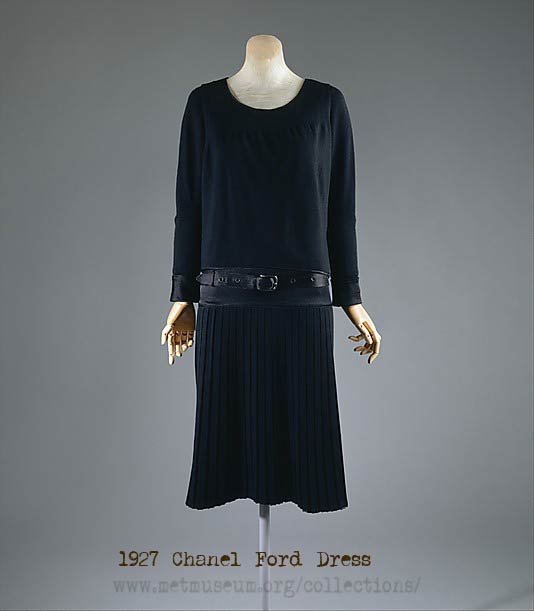
” the frock that all the world will wear is model 817 of black crepe de chine. Bodice blouses slightly at the front and sides and has a tight bolero at the back. Especially chic is the arrangement of tiny tucks which cross in front. Imported by Saks.”
There was about it- no trumpets blaring, but a humble beginning as a day outfit, which Chanel was soon to follow with numerous black evening dress styles, which helped copper fasten the idea of the ‘the little black shift dress’ as a simple flattering ‘must have’ in every girls wardrobe.
The Screen Debut of the Little Black Dress
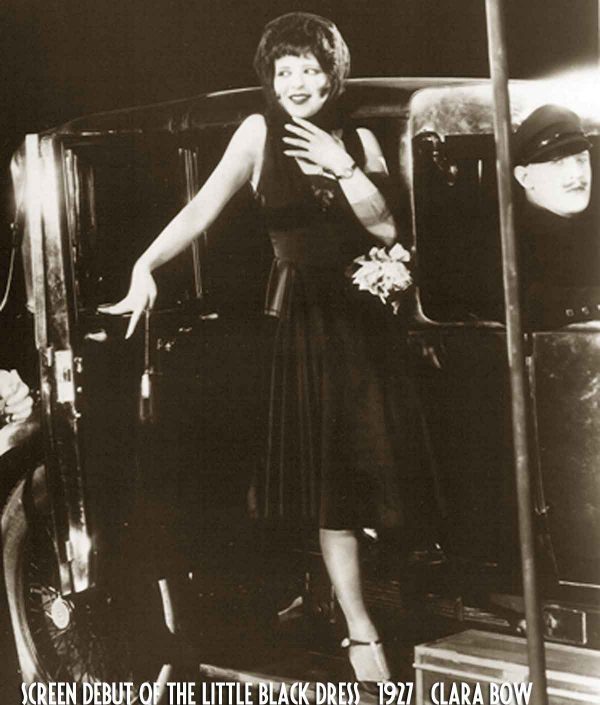
The real kudos for the ‘sudden’ popularity of the little black dress goes to Hollywood designer Travis Banton and Clara Bow. In the first half hour of the iconic movie IT(1927) a highly fashionable pleated frock is worn by Bow at her work place. This same frock is then transformed into a sleeveless little black dress that had cinema goers eyes popping out of their heads. A fashion craze was born. And a color normally reserved for funerals was suddenly a must have in a woman’s wardrobe.
1920’s Fads
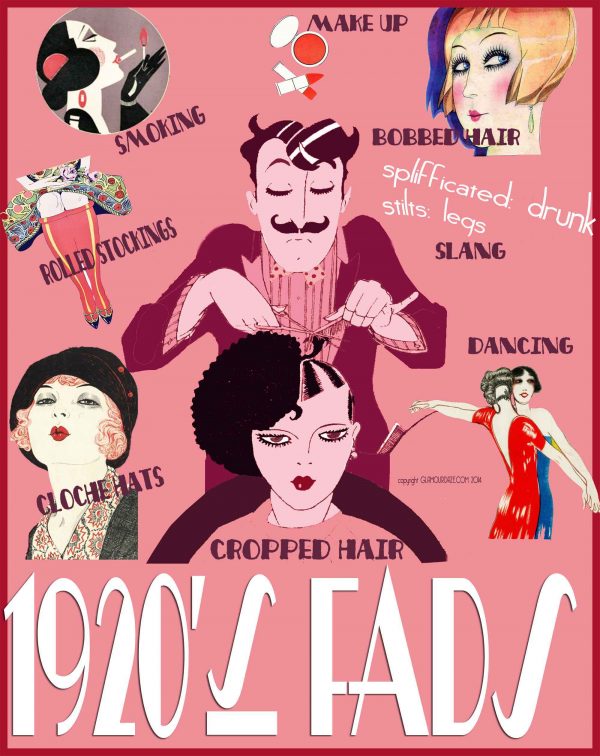
- Bobbed or cropped hairstyles
- Dancing to the Charleston and the Black Bottom dance
- Smoking
- Rolled stockings
- Flapper slang
- The ubiquitous cloche hat
- Jazz music
- Mahjong parties
2.Art Deco Fashion

As early as 1908 – when Paul Poiret produced his Les Robes De Paul Poiret – illustrated by Paul Iribe -a total break away occurred from the conventional presentation of new lines in clothing.
Paul Iribe, was one of the original seven Knights of the Bracelet – which also included George Barbier, George Lepape, Charles Martin, Andre Marty, Bernard Boutet De Monvel, and Pierre Brissaud. Their divine illustrations graced the pages iconic fashion magazines like Gazette Du Bon Ton, and Art-Goût-Beauté .

The Impact on 1920’s Fashion of illustrators
These artists of the Art Decoratifs movement were collectively responsible for breathing their fresh Expressionist colors and flowing graceful lines into the world of fashion throughout the 1920s and on into the 1930s.

In 1925 at the Exposition Internationale des Arts décoratifs et Industriels Modernes Paris – fine art and fashion finely merged and what we can only describe as the Age of Chic was born!

Art Deco and the Changing Silhouette of Women in the 1920’s
Evening gowns in the first season of 1921 were of unusual magnificence, luxurious works of decorative art. Gowns draped on women of impossibly refined silhouettes now declared a new ideal of beauty – slenderness. The feminine shape was decreed to be straight and angular, echoing the influence of Les Arts Decoratifs .Just as in the Belle Epoch era of the 1900’s – the curved shapes of Art Nouveau were echoed by the buxom Gibson Girl.

Until fashion photography took its place in 1930s film magazines like Hollywood’s Photoplay, the magazines of the period, displayed a simplicity that is striking. ” Longer than life young ladies, with their short, tubular dresses, cigarettes in long black holders, cloche hats, bobbed hair and hands of diamond bracelets” [ The Golden Age of Style ].
3.The Evolution of the 1920’s Silhouette

Leaving behind once and for all the ‘ S ‘ bend corset look of the Edwardian age, it was only natural that the modernist influenced lines of the 1920’s would go to a polar opposite of – no curves at all, straight figure, flat chests and boyish look. It was a battle between the feminine and the modernist.
The Garcon Look and Robe de Style
At the start of the decade the couture designs from Paris drew mostly from historical lines, with nipped waists and billowing skirts – called Robe de Style ( a trend that was to be repeated in the 1950’s).

The 1920s fashion visionary Jeanne Lanvin was a major exponent of the robe de style, producing beautiful pastel mother and daughter wardrobes. Lanvin popularized the ‘garcon look‘ – a simple chemise dress in either day dresses or evening wear. It became the dominant fashion line from 1923 to 1928. Coco Chanel was the favored young gun for this youthful boyish style. She wore this look to great effect and became a favorite of the press, as a result.

The fringe mini-dress is often seen as the typical evening gown from the 1920’s. It is a popular misconception brought about by the 1960’s revival of certain 1920’s fads.
4.Modernism in Fashion

While fashion is constant, design is ephemeral. Modernism in fashion can be defined as a style or movement in the arts that aims to depart significantly from classical and traditional forms.. It could be said to that fashion modernism began with Paul Poiret, through the illustrations of Paul Iribe, but it was the 1920’s breakaway from traditional dress that truly earns 1920’s fashion its title of the term modernism.
By April 1925, when the ‘Exposition internationale des arts décoratifs et industriels modernes‘ opened in Paris with exhibits from twenty eight nations, Decorative arts and design or Arts Decoratifs was merging with a new ‘modernist’ appeal that that was anti-decorative and almost industrial.
Modernism brings about Chic
Though nowadays referred to as Art Deco, the look that was to dominate up until the late 1930’s, was a combination of feminine and ‘modern’ industrial inspired designs. It was the ‘Age of Chic’ – a word that found itself into the vocabulary of almost every fashion article or advert written.” Sequinned dresses are chic for evening …..A smooth skin is chic …..The new short bob is chic ….”

Art Deco style was the dominant feature, not only in modernist fashion, but in all creative arts right on up to 1939. Hollywood endorsed this new demure style with imaginative film sets and stunning gowns adorning their female stars.

The names of the movie costumers as were as well known as the Paris Couturiers. Gilbert Adrian, Orry Kelly, Travis Banton, Edith Head and later – Walter Plunkett,whose wonderful costumes for the 1953 film Singin’ in the Rain, brilliantly parodied the over the top exuberance of 1920’s Hollywood.
The IT Dress
The aforementioned memorable scene from Clara Bow’s IT, where she took a scissors to her work dress and transformed it into an evening frock. The dress was realized by Travis Banton and it officially launched the little black dress on screen.

The word ‘chic’ was made popular in the hugely funny comic novel Gentlemen Prefer Blondes by Anita Loos, published in 1925. The Great Gatsby may be remembered as the definitive book about the jazz age, published that same year, but much is to be said about this mini Jazz Age masterpiece by Anita Loos, who introduced the worlds ‘first’ dumb blonde on the make.
The Top Designers
The major designers in modernist fashions included Chanel, Lanvin ( who always seemed to be a step ahead of the younger ones) and new surrealist designers like Elsa Schiaparelli ( who first splashed on to the fashion scene in 1927 with her trompe l’oeil bow sweater) and Sonia Delauney.

Soon, 1920s fashion periodicals were copying their chic designs of stripes and colorful blocks in dresses, jumpers and sportswear.

5.1920’s Dress

1920’s Day Dress
The middy blouse, which American women had for some time found practical, arrived in Europe in 1917 with the American troops. Its impact was considerable. The middy inspired young designers like Coco Chanel to incorporate jersey and other traditionally male fabrics, to create the first genuine casual clothing for European women. The staple day-wear look for women was a combination of pleated skirts, loose belted jumpers and loose cardigans.

It is difficult to say with any accuracy who first created the drop waist look. There are designs by Jeanne Lanvin as far back as 1914 which show these styles – albeit worn by younger girls. Coco Chanel had published a collection of evening gowns in 1916 in Harpers Bazaar which showed a clear move towards a drop waist style, achieved with loose fitted belts.
By 1923, the drop waist look was taking hold. You wore a skirt with low hanging belts, and a dress with a faux drop waist sewn in.

By 1926, most spring and summer dresses were sleeveless or cap sleeved scoop-neck lightweight dresses with a lowered waist or no waistline at all. Day wear evolved into simple layered suit-styled jackets or cardigans, jersey blouses, and pleated skirts.
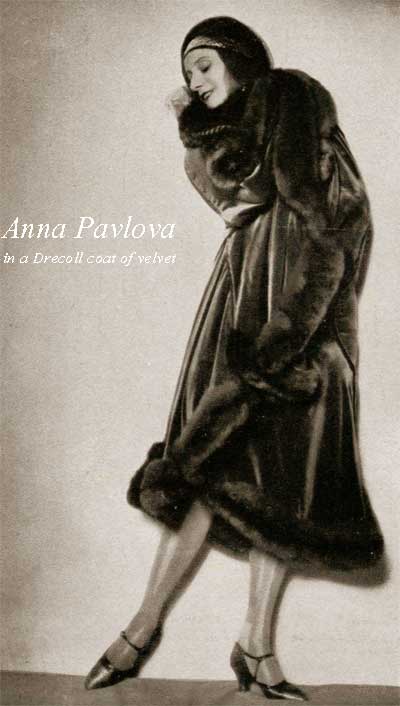
The wrap-over coat in tweed was the favorite winter coat, and if you could afford it, you draped your self in velvet and furs. Opulence was the key.
1920’s Formal Dresses

Madeleine Vionnet and the Bias Cut Dress
1920’s formal dresses were the domain of the great designers. Madeleine Vionnet popularized the bias cut, where a woven fabric, mainly silk, was cut at a 45 degree angle to its major seam lines. This allowed the fabric to hang and drape in sinuous folds and stretch over the contours of a woman’s figure. The beauty of the bias cut, was that the dress could be pulled on and off with ease.
It heralded the free-form look of many evening gowns in the 1920’s. The fabrics, often from the Orient, were often highly decorative.

Popular 1920’s evening dresses were designed with a straight tabard-style with side inserts, which featured low cut backs and thin shoulder straps. And no evening dress was complete without a luxurious fringed shawl to drape over the shoulders. Many frocks were heavily encrusted with beads and even jewelry. The completed ensemble created a statuesque like effect.
The Flapper Dress

Chanel’s black evening dresses with huge transparent draperies.
Molyneux’s transparent printed dresses with full scalloped skirts and arm draperies.
Paquin’s acid green moire dresses with a V-neck and bulk at the hip.
source –Vintage Fashion Sourcebook – Carlton Books
The Real Flapper Dress vs The 1960’s Reboot
The current abhorrent flapper party dress is a myth. It is a relic of the 1960’s revival. Frocks were weighed down with elegant bead work, a particular feature in a 1920’s evening dress. The ubiquitous fringe flapper dress was actually quite rare. Hemlines rose to just below the knee. Silk was the favored fabric in chiffon, velvet and taffeta. This newer freedom in skirt lengths was enjoyed by women for the swishing feeling against their legs whilst dancing.

With all the new music to dance to, many gowns were designed with freedom of movement in mind. A swishing frock was important to a party going girl. For the working class girl, the new fabric Rayon – an artificial silk, was the less glamorous alternative.
Home Dress Making and the emergence of Ready-to-Wear

Ready to wear clothing was in the future, and most women of moderate means simply went out and bought the latest McCalls, Pictorial Review. They would subscribe to the sewing patterns published by design gurus like Mary Brooks Picken from the Women’s Institute. Her 1920’s Dress Design book ‘Modern Dressmaking’ was extremely popular among home-dressmakers and copies are hard to find now. Fashion houses brought out new lines twice a year in the 1920’s. The cuts and appliques were eagerly consumed and copied by fashion magazines around the world.

The electric Singer sewing machine revolutionized the speed at which nifty women were able to knock together their new dress for a coming weekend dance.
6.The 1920’s Flapper

When you were referred to as a bit of a flapper in the 1920’s, it was not kindly meant. But there was indeed a flapper look and it has endured to this day as the defining, though not accurate, look of the decade.The Silhouette was tubular, the backless chemise dress – outrageous! A lowered waistline, bobbed hair, feather boas and long necklines and cigarette holders. The new slang and oodles of faux jewelry completed the effect of the quintessential flapper.

The Spirit of the Flapper
Cartoonists such as John Held Jr , Rene Vincent ,and Georges Leonnec, whose hilariously naughty La Vie Parisienne illustrations stretched back to La Belle Epoch era, also helped epitomize and immortalize the youthful spirit of the flapper.

The greatest 1920s fashion parody of them all is the truly hilarious PG Wodehouse series of Jeeves and Wooster novels, which captures the spirit of the Jazz Age among London’s and New York’s ‘bright young things‘.

It was the enduring image of the flapper given to us by Hollywood which secured the legacy of those bright young people.
The Hollywood Flapper

Audiences were mesmerized by those early icons of the silver screen such as Theda Bara, Gloria Swanson, Alice White, Louise Brooks, Clara Bow and Colleen Moore. They inspired millions of women to copy their fashion, coiffures and make-up looks. Dorothy Parker had a thing or two to say about these vivacious women:
The Playful flapper here we see,
Fairest of the fair.
She’s not what Grandma used to be, –
You might say, au contraire.
Those girlish ways may make a stir,
Her manners cause a scene,
But there is no more harm in her
Than in a submarine.

The Lesbian Effect
The 1920s flapper ideal also became associated with a new lesbian chic popularized by the book La Garconne by Victor Margueritte, and epitomized now by the artwork of Tamara de Lempicka, whose iconic auto portrait (Tamara in the Green Bugatti) for the cover of German fashion magazine ‘Die Dame’ is regarded as one of the most significant paintings of the era.

The lesbian artist Gerda Wegener (nee Gottlieb) whose portraits of her transgender partner Lili Elbe have also become iconic images of the liberated 1920’s woman.
7. 1920’s Hairstyles and the Cloche Hat

Hairstyles of the 1920s – as with most other aspects of the 1920’s woman’s look – were short short short !
Crop it and be damned !
The First World War forced many women – who worked in dangerous situations like munitions factories – to tie up their hair or in many cases, crop their locks altogether. The ‘short crop’ or ‘chignon‘ hairstyle became so common in Holland, France and Germany by 1918 that soon famous stars like Irene Castle were playfully adopting them. In response, milliners answered the call by designing closer fitting hats. French milliner Caroline Riboux developed the ‘cloche hat‘ ( meaning ‘bell’) in 1919 which was often fashioned round a clients head.
Buy these beautiful handmade Cloche hats from La Vie Delight on Etsy.

As with the simple gamine trimmed dresses of the 1920s, hats lost their quills, bows and ribbons and the off the face type which fitted well down over the head became the mode by 1921. The Cloche was always worn down over the eyes. It gave the 1920’s woman a mystique.
Riboux’s “Gigolo” crown, with its crushed style, was one of the highlights of hat fashion in 1925.

Rose Descat was the other leader in cloche hats in the late 1920s and early 1930’s. She made the cloche a universal fashion item with her molded crowns and eye-shading brims. This 1920s hat style was teamed up with shingled cropped hair to give us the definitive 1920’s look.
1927 Cloche Hats in AI Enhanced Film
By 1922, Ladies found that there was a whole new war going on – hats versus hair!
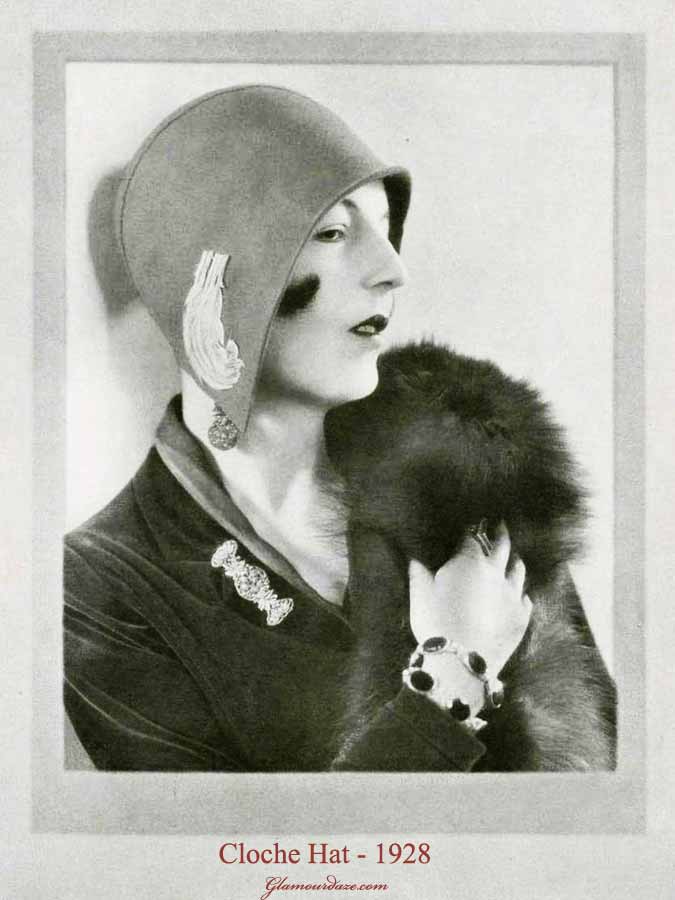
They would hastily repair to their unfortunate hairdresser and tell him he was a rotten hairdresser and thanks to him, they couldn’t find a suitable hat!
The Cloche hat timeline – 1920 to 1929

Hence the astute hairdresser began more to ‘thin’ out the hair until the back adornment was a simple ‘chignon‘ that could be tucked under these new cloche hats.The milliners struck back with an evolved hat style that couldn’t accommodate even this tiny “bun”.
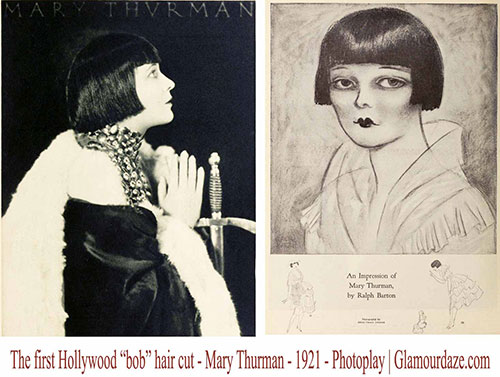
The hairdressers retaliated with the ‘crop’, a new bob hair cut, a variation on a finger wave. Then there was the ‘shingle‘ which was popularized by Polish born Antoine De Paris.
Popular 1920’s Hairstyles

- The Bob
- Chignon
- Shingle Haircut
- Marcel Waves
- Finger Waves
- Eton Crop
It took a great deal of courage in the early 1920’s for a woman to take the shears to her locks. The forerunner of the bob was the chignon, tied up in a psyche knot.
Top Ten 1920’s Bob Hairstyles

- Dutch Bob or Page Boy Bob
- Eton Crop
- Shingle Haircut
- Charleston Bob
- Wind-Blown Bob
- Brush-back Bob
- Frizz Bob
- Kiss Curl
- Orchid Bob
- Poodle Bob
There was the Dutch bob or Pageboy bob. Orchid bob, Eton Crop and Egyptian bob. Coconut bob, Moana bob or the The Charleston Cut. The Shingle, Kiss-curl or Extreme Windblown bob. The Frizzy Tousled Bob, Poodle Cut or Soft-wave-Bob. And did we mention the Brushed Back Bob?
Short Bob Hairstyles

The Dutch bob hair cut , first made popular in the USA as far back as 1921 when Mary Thurman adopted it was to become the most sought after bobbed hairstyle. By 1926 the short bob hairstyle was popularized by the likes of Colleen Moore and Louise Brooks. This page boy bob is the most iconic hairstyle of the 1920’s.

Why did 1920’s Girls bob their hair?
The singer Mary Garden explained to the Pictorial Review in 1927, why she bobbed her hair;
“Why did I bob my hair? For several reasons. I just wanted to. It’s easier to take care of. I thought it more becoming, and I felt freer without long, entangling tresses. My short hair typified a progressive step. It was in keeping with the inner spirit that animates my existence.”
Bernice Bobs her Hair
F-Scott Fitzgerald also immortalized the bob in his short story Bernice bobs her hair.
“I want you to bob my hair.”
The barber’s mouth slid somewhat open. His cigarette dropped to the floor.
“Huh?”
“My hair–bob it!”
8.1920’s Makeup
Read our History of 1920s Makeup for the more detailed illustrated story of how the consumer boom in women’s make-up really took off in the roaring twenties. Cosmetics counters were fast becoming the norm in ladies departments stores and pharmacies.

Beauty became a major business, with names like Max Factor ( the famed Hollywood make-up designer), Helena Rubinstein and Elizabeth Arden becoming household names and brands like Maybelline, Tangee and Coty rolling off girls lips.

The singular evening makeup look of the 1920’s was the cupids bow lips, heavily rouged cheeks and kohl shadowed eyes. In the daytime hours, it was now quite acceptable to wear lipstick. Makeup was now heavily marketed towards women and was to become a major industry.

1920s beauty guides were featured regularly in magazines and the new ‘American-style-beauty as evoked by Hollywood was the ‘image idéale’ to be achieved.
Authentic 1920s Downturned Eyes Makeup Look c.1922 | Tutorial
Irina @retrofrog created a truly stunning authentic early 1920s makeup look for GlamourDaze. The downturned eyes or sad eye look. The cupids bow lips, the kohl eyeshadows. Perfection. Just follow this tutorial and you will have men dropping at your feet.

For a complete and lavishly illustrated guide to the history of make-up in the 1920s – Read the History of Make-up -The 1920’s or visit Vintage Make-up Guide.com for downloadable vintage beauty guides!
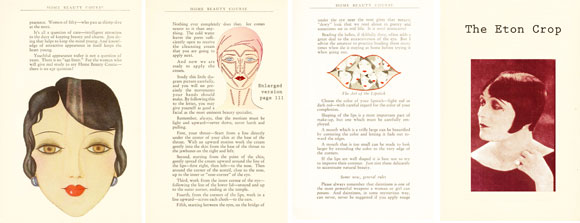
The Real Flapper vs The Silent Screen Vamp Look.

Talia Felix wrote an interesting study for Glamour Daze, on the illusion of 1920s make-up styles of Hollywood starlets, filmed in high contrast ortho-chromatic. In the photo, Talia demonstrates the makeup worn to it’s appearance in high contrast black and white.
Most women were conservative in day make up, but the new push up lipsticks were to become every girls constant companion.
9.1920’s Accessories
The 1920’s Bathing Suits

In the 1920’s – women’s swimsuit design rapidly evolved from the hideous petticoat affairs to the sleek, body hugging apparel of the Jantzen Swimsuit,an elasticated and revealing skin tight one piece which possibly did more for the emancipation of the female body than any other item of outerwear clothing . Women of a daring disposition could not wait to jump into them.
Jantzen Swimsuit
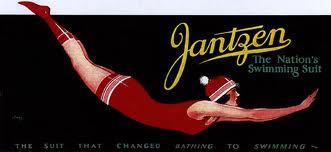
The famous Diving Girl logo heralded a new age of freedom and first appeared in beauty pageants in the early 1920’s and very quickly a swimsuit mania swept across the world. It was Jantzen, originally called the Portland Knitting Company, who changed the name from ‘bathing’ to ‘swimsuit’ in 1921.
Parasols were as ever – a popular beach accessory, and are sadly missed from today’s beach fashions.

It wasn’t until the 1930’s that Lastex, a woven satin finish elastic and silk material, also used in girdles, began to be used.


The Swimsuit evolves
In the early 1920’s – the popular style was to wear black rolled stockings with your swimsuit,thanks to the Max Sennett’s Bathing Beauties, though this idea – however charming to look at, disappeared within a few years. Top designers such as Jean Patou and newer emerging talents like Sonia Delaunay believed that fine art could be integrated seamlessly into textiles and clothing.

Originally a painter, Delaunay’s vibrant colors and cubist shapes were a marked contrast to the minimalist styles of most bathing costumes.
The 1920’s St Tropez set, the name for the myriad European holiday resorts for the rich and famous, captured the spirit of the 1920’s like no other single phenomenon. Names like Deauville, Biarritz, St Tropez, Cannes, Nice and Monte Carlo epitomized the glamour of the era, as did the notorious Atlantic City, New Jersey, and Palm beach resorts in the USA.
Beach Pajamas and Breton Tops
Pants, or slacks were not yet acceptable on the high street. However in summer, it was increasingly common to wear slacks on holiday. Coco Chanel wears pants and a striped marinière or Breton sailor top here in 1928.

She is incorrectly credited for bringing the mariniere, as well as the fad for beach pajamas in the 1920’s. There is no evidence to support this from her collections of this period. Her fondness for the garcon look, however, certainly helped popularize these styles.
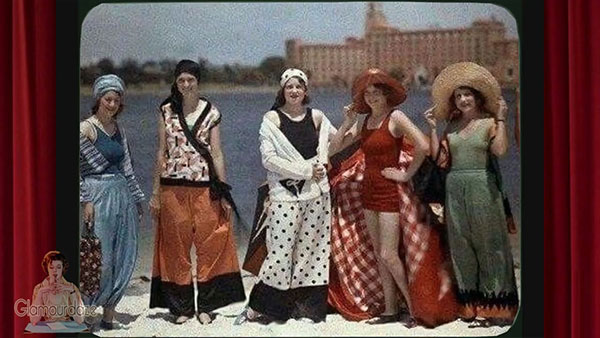
Lingerie and Stockings in the 1920’s

The post 1918 evolution of women’s lingerie in the 1920’s was equally dramatic.
By the end of the 1920’s, gone was the cupboard full of billowing snow white linen. Layers of day and night chemises, drawers, knickerbockers and petticoats vanished. Replaced by just a few pairs of Cami-knickers and princess slips.

Lingerie fabrics were of silk, crepe-de-chine, rayon and a new soft transparent fabric “crepe Georgette” devised by Chanel contemporary Georgette de la Plante.

Women did not abandon corsets completely in the 1920’s. Long-line elasticated smooth corsets replaced the old laced affairs of the previous decade. These newer synthetic corsets now employing zips down the side, doubly served to enhance the tubular look which women wished to achieve. The one-piece camisole replaced the old cotton chemise, now made in silks, cut low to wear under evening dresses.
The leading brands in 1920’s lingerie

Leading brands of foundation wear in the 1920’s included Gossard, Spirella, Berlei, Symingtons ( the Symington side-lacer) and Sears Roebuck and a new company called Maidenform – formed in 1922 – who put out a new bust uplifting bra which – despite the gamine flat bust fad – began to take hold by the late 1920’s. Pre-code Hollywood movies of the late 1920’s took enthusiastically dis-robed many of their female stars to show off undergarments.
Legs become the new fashion


A unexpected arrival in fashion from 1920 onward was the new fashion of ‘exposing women’s legs.’ 1920s stocking sales rose inexorably.
The sudden rise in skirt hems brought with it a desire by women to wear more attractive and fashionable hosiery. Stocking Brands like Phoenix, Onyx, Berksire and Holeproof Hosiery were advertised in exquisitely ornate and risque adverts by artists like Coles Philips.


In 1926 Wall Street Journal reported that Hole-proofs annual sales had increased from $2,037,000 in 1916 to $9,220,000 by 1925. A fascinating study of women’s hosiery advertising in the 1920s by Jean Elizabeth Harrison revealed the following graph study of Leg Exposure in women’s hosiery advertising from 1920 to 1929.

1920’s Shoes

In the 1920’s, there were three common types of women’s dress shoe: T-straps, Ankle Straps, and Pumps.
The Shoe Icon Museum Gallery
Below is a small selection of beautiful 1920’s day and evening dress shoes – from the excellent Moscow based -on-line shoe museum Shoe Icons – a veritable Aladdin’s cave for all women’s shoe fans.
Daytime Dress Shoes
The Cuban-heeled court shoe was the most common footwear for daytime. The Mary Jane shoe with it’s single button strap across the ankle and it’s pointy toe was a favorite for women. It was named after a character in the Buster Brown comic strip, illustrated by R F Outcault.
Evening Dress Shoes
In the early 1920’s, shoes were quite Edwardian in nature, with pointy toes. The favored fabrics were luxurious silk satin, velvet or lace in black or white or brocaded designs. Shoes had Louis heels or the chunkier Cuban heel.

The top 1920’s Shoe Designers
Long before the name of Jimmy Choo or Prada became synonymous with women’s fashion shoes – the two names which every woman of means sought out in fashionable shoes during the 1920’s were André Perugia and Salvatore Ferragamo.
Born in Nice, France, Perugia was the first major shoe designer of the 20th Century. His Italian counterpart Ferragamo was the darling of Hollywood’s brightest starlets. A visionary and exponent of modernist patterns and innovative materials. His most popular heels were made from cork.
Vintage Inspired 1920’s Shoes
You’ll find many rare one of a kind 1920’s shoes, pumps and sandals on Etsy.
Stores like UK Charm Vintage and Wild Irish Rose Vintage have some beautiful shoes from various eras.

10.The End of the Flapper Era

Had a fashionable Edwardian lady of 1909 hopped on to HG Well’s Time Machine and zoomed forward just 20 years, she would have thought she was on an alien planet.
The girls around her would have seemed emaciated. They clearly were in desperate need of food and clothing! The sheer legs of the 1929 woman, her painted face and cropped hair would have shocked her beyond words.

The inspirational Paris based travelling ballet company Ballet Russes also came to an end after a 20 year run which had helped revolutionize 1920s fashion. Its founder Serge Diaghilev died with substantial debts, forcing the closure of the company and dispersal of its dancers.
The Hemline Index Theory

It appeared in the weeks following the Wall Street Crash in October 1929 that the Hemline Index theory by economist George Taylor in 1926 was coming to pass. The unveiling of the Chatillon-Mouly-Rousse Autumn Collection by designer Jean Patou presented a dramatic drop in hemlines to the ankle and skirts hanging on the natural waist again. Of course the hemline index theory could be all bunk, as suggested by Jenna Sauers of Jezebel.
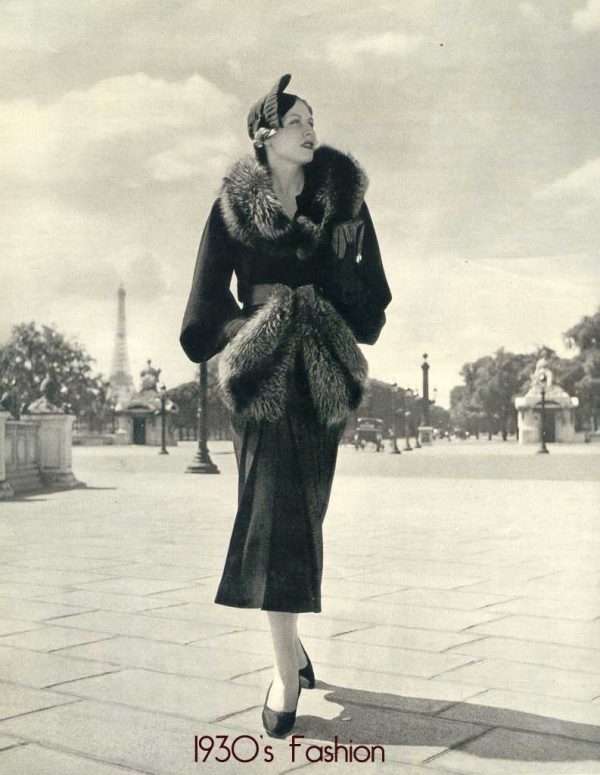
Earlier that year designers like Jeanne Lanvin and Bernard & Co as well as the almost forgotten Jean Michelline, were dropping hems in both day and evening wear to suit a less throwaway culture in fashion houses. Madame Fashion had decreed a move to more conservative uses of fabric.
Farewell to the Flapper
The Spring collections of 1930 were returning to the feminine. As a result female shape was in vogue again. A silent revolution grew among fashion designers,couturiers and stylists. Hair loosened up and waves were becoming softer. Sales of girdles and newer more comfortable shape wear rose. The severe angular lines of 1920s fashion grew less a la mode.
The era of the flapper was over, that chic gamine girl, with her shingled bob and beaded short dress. We’ll never forget her, that vivacious young woman of the 1920’s. She lit a fire that has never gone out. It glows to this day.
Further Reading:
A Short History of Fashion – 1900 to 1969
History of Fashion – 1900 to 1919
The Concise Illustrated History of 1940s Fashion – 1940 to 1949
Bibliography – More Reading and Sources:
Dressmaking Research.
Fashion since 1900 – Valeria Mendez & Amy De La haye.
The Golden Age of Style – Julian Robinson.
A History of Feminine Fashion.
Flappers and their Flawless legs
The Little Black Dress – from Chanel to Givenchy.
Coco Chanel – the Met Museum Collection.
1920s hairstyles – 12 classic bob cuts.
Fabulous Fashion (1907-67), Wilke & Co Ltd, Clayton (1985)
University of Chicago.
Why I bobbed my hair – Mary Garden.
The 1920s Berlin Project.
Trasko, Mary. Heavenly Soles: Extraordinary 20th Century Shoes.
1920’s Fashion – Women’s Dress and Style
Shoe Icons
Knowlesville.
The Photo Detective UK.
















